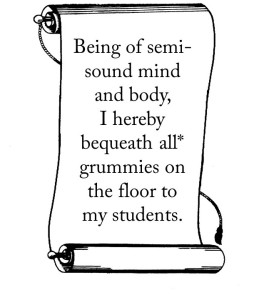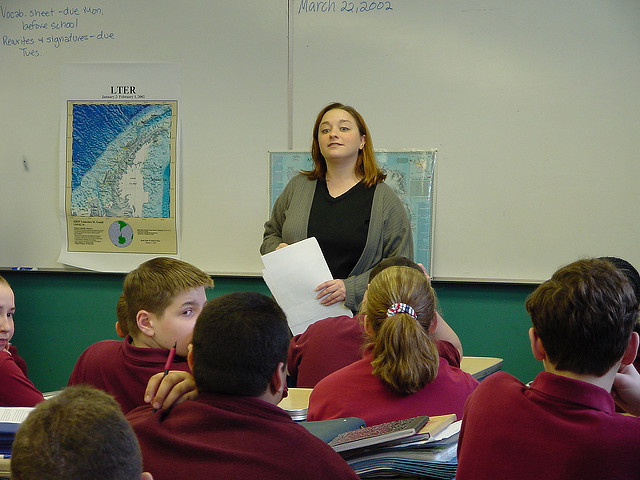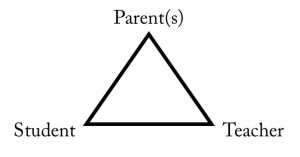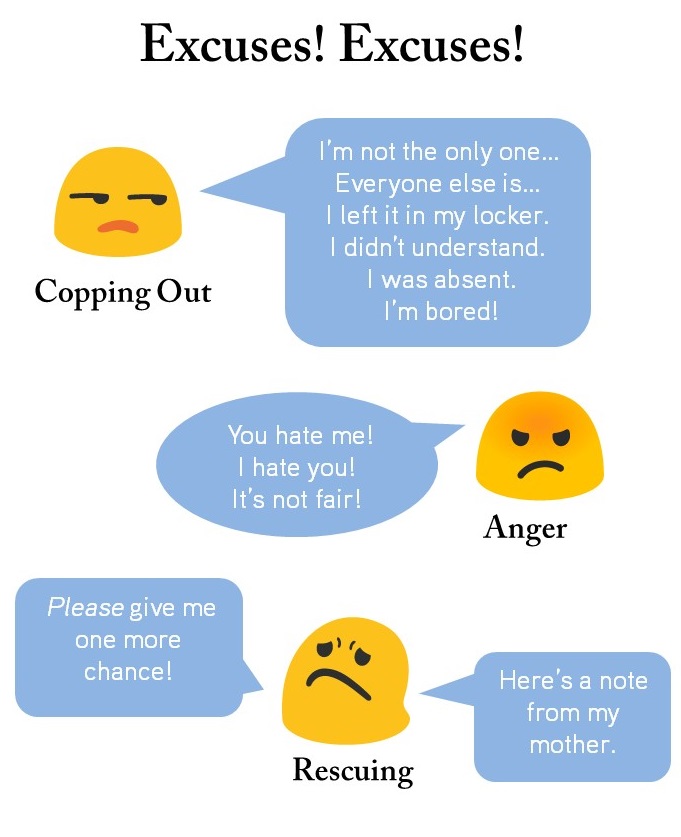Main Body
An Effective Learning Environment
One of any teacher’s essential tasks is creating an environment where students feel safe to be and safe to learn. Many factors must be considered.

8. Fostering a Cooperative Spirit
It’s unreasonable to expect students to be “friends” with everyone in the class. However, if students are going to be successful, they must learn to accept each other, to work together, and to support each other. Two of the most important steps you can take to make this happen are to have students learn each other’s names and to address the benefits of working together.
Learning Names
Here are some ways students can learn each other’s names:
Examples
- Have students interview each other and then introduce each other to the class. They might include their name, something they like to do in their spare time, and something they would like the class to know about them.
- Students go up one by one to the overhead, write their name, and write a food they like that starts with the letter of their first name. For example, “I’m Frank, and I like French fries.”
- Students go around the room and “pack a suitcase” for a trip. Students take an object that starts with the first letter of their first name. For example, “I’m Terry, and I’m taking toothpaste.”
How I will have my students learn each other’s names
_______________________________________________________________________________
_______________________________________________________________________________
_______________________________________________________________________________
The Power of Working Together
When students laugh at others who make mistakes, who have a physical impairment or speech impediment, or who behave inappropriately, the success ratio in a classroom plummets! Students must be aware of the power that comes from sticking together and working together. Here are two possibilities for introducing this concept:
Examples
- Take one toothpick and give it to the strongest child in the class. Tell the child to break the toothpick and then report back how hard it was to do. (It’s simple!) Then give the same student a bunch of toothpicks. Ask the student to break the whole bunch in half—at one time—and then report back how hard it was to do. (It’s impossible!) Discuss the lesson to be learned from the toothpicks. (If students stay together and work as a team, nothing can break them down or keep them from being successful.)
- The legions of the Roman Empire were known for their power. One of their most famous formations involved the use of their shields that were waist high and made of wood and leather. When attacked, the soldiers got in a tight bunch and interlocked their shields in a “shell” which covered them on all sides and the top. This formation was called a testudo (turtle). With it, soldiers withstood heavy blows from the enemy. Explain that students are the legions, and their enemies are poor grades and lack of personal success. If the students stick together and support each other, they will be victorious!
!["Group Protection" by Michael Coghlan [CC-BY-SA 2.0] https://flic.kr/p/a1KdM4](https://milnepublishing.geneseo.edu/app/uploads/sites/16/2016/12/5915643709_0d815d7d72_b-300x225.jpg)
“Group Protection” by Michael Coghlan [CC-BY-SA 2.0] https://flic.kr/p/a1KdM4
How I will teach the importance of “sticking together”
_______________________________________________________________________________
_______________________________________________________________________________
_______________________________________________________________________________
9. Civility in the Classroom
Expectations for Your Students
You have the authority and the obligation to set an expectation for civility and propriety in your classroom. This includes what is acceptable in what students say (not only to you, but also to each other), and what they write. Once the standard has been set, you need a “catch” word or phrase to use as a reminder when they stray. Here are some possibilities to consider:
Years ago, bus stations were always in the worst part of town. They never represented the best that any town or city had to offer. Hence: Stay out of the bus station! —Roberta Ford
Whoa! —Hollie Drake
Easy! —Steve Smith
A stream usually starts out relatively pure and becomes more and more polluted as you get further downstream. Hence: Stay upstream! —Eric Pear
To further support the spirit of civility, you must let students know that you expect them to use the words “please,” “thank you,” and “excuse me” in their interactions with each other and with you. Also remind them that “shut up!” may be OK for TV reality shows, but it’s one of your pet peeves and is unacceptable in your classroom. Model that behavior when you are working with them!
My cue for propriety/civility
_______________________________________________________________________________
_______________________________________________________________________________
_______________________________________________________________________________
Note: Do not be swayed by students’ claims that “No one else cares what we say,” etc. We’ll cover the issue of their pleas, challenges, and alibis later in “Excuses! Excuses!”
It’s vital that students learn an effective way to deal with you about conflicting viewpoints or concerns. Whether it’s a question about the way you enforce classroom rules or grade a paper, the keys are timing and demeanor! Here are some suggestions.
Examples
- Do not use class time to answer individual questions about grades on assignments or tests. Have students politely write their question(s) on the paper and turn it in to you at the end of class or at a specifically designated time and/or place.
- Discuss the adage that, “You get more flies with sugar than you do with vinegar.” (Students are more likely to get the results they want if they approach you sweetly and gently—and at an appropriate time.)
- Role play! A student plays the teacher; you play the student.
- Scene 1: While “teacher” is giving direct instruction, “student” storms up, throws the paper in the “teacher’s” face, and loudly announces, “You made a mistake on this paper, and I want my grade changed now!”
- Scene 2: At a quiet moment, “student” approaches the “teacher” on his/her knees, gently puts the paper on the “teacher’s” desk, and says in a soft sweet voice, “Dear overworked underpaid teacher, I know you have more than enough to do, but I was wondering if you would be so kind as to look at the answers I circled on my paper. I think you made a tiny mistake in the points you gave me.”
- Acknowledge the obvious exaggeration in the second example and then discuss the relative effectiveness of both approaches.
How I will teach the right way to deal with conflicts
_______________________________________________________________________________
_______________________________________________________________________________
_______________________________________________________________________________
Expectations for Yourself
If we expect students to treat each other in a civil manner, we teachers must model that same civility when we deal with students. We must treat them with respect as we conduct the business of school. This respect is shown most clearly in our approach to classroom management. (I deliberately choose the term “classroom management” rather than “discipline” because the former has the implication of helping students change their behavior—always our goal—while the latter suggests punishment.)
Effective teachers have and incorporate a gradually escalating hierarchy of interventions for dealing with student behavior issues. Effective teachers always try to keep the students in the classroom and learning. Effective teachers know that the key is to start with the lightest corrective touch possible but have firmer alternatives if that doesn’t work. Here is an example of one such hierarchy.
Examples
- General expectations
- Specific rules that expand the general expectations
- Friendly, nonverbal interventions
- Friendly, verbal interventions
- Formal Behavior Remediation Plan
*May or may not incorporate a Behavior Modification Plan
The next section will help you develop your own hierarchy.
Note: Please keep in mind that you may have to skip steps in the sequence depending on particular situations. Also, when you become aware that certain students will challenge your ability to change their behavior, it is a wise move to alert their deans or designated administrator to the situation. Explain what you have done already and what you plan to do as the need arises. That way there are no surprises if those students eventually show up in someone’s office.
10. General Expectations
Students must know your general behavior expectations. These should be brief (No more than five!) but cover all possible situations. Furthermore, they must support your philosophy and goal(s) so that you have a clear answer for those students who ask, “Why?” Here are some examples:
4 P’s: Polite, Prompt, Prepared, Participate —Martha Riley
Respect. Responsibility. —Noel Reck
- Show respect
- for yourself.
- for others.
- for the environment.
- Be on time.
- Be prepared.
- Do your job. —Roberta Ford, Mary Dove, & Lou Baldelli
Note: Some teachers like to work with students and have them develop these expectations. Others simply tell them to students.
My general rules
_______________________________________________________________________________
_______________________________________________________________________________
_______________________________________________________________________________
11. Specific Rules
It would be wonderful if general guidelines were enough, but many students also need specific rules—and there definitely will be more than five! Here are some examples to consider. Put a √ beside the ones that you will address.
__ All electronic devices are banned from view, hearing, or vibrating.
__ Food/beverages/containers are banned.
__ Passes from the teacher are required for leaving the room.
__ Stay seated during direct instruction.
__ Gum is banned.
__ Class is not dismissed until the teacher gives the official signal.
__ “Egging on” and saying, “Shut up!” are banned, even with friends.
__ Pick up the grummies (any trash on the floor) before leaving.
__ Stay in seats, not lined up at the door, until dismissed.
__ Hats, worn or visible, are banned.
__ Intimidation of any kind and/or fighting are banned.
__ “Making baskets” with trash is banned.
__ Weapons (real, looks like, used as) are banned.
__ Harassment, sexual or otherwise, is banned.
Others to include
_______________________________________________________________________________
_______________________________________________________________________________
_______________________________________________________________________________
Note: Many teachers state all rules in positive terms. Also be aware that having rules is one thing, but enforcing them is another. Be consistent in your expectations!
About the Grummies…
Because I believe that students should show respect for themselves, for others, and for the environment, I expect them to tidy up the room before they leave. This includes picking up all the little bits of paper and trash that have accumulated during the period. It helps to give this refuse a friendly name. I use the term “grummies.”
Of course, there are always those students who say, “It’s not my trash!” or “I didn’t put it there!” By reading to them the Grummy Will on the next page, I put a permanent end to those arguments in a positive way. “Goodbye!” debates; “Hello!” clean room.
If you share a room with other teachers, I encourage you to ask them to participate in the clean-up procedure.
Grummy Will

12. Friendly Signals
Silent Signals
Of course, it will be necessary from time to time to give friendly signals to students who stray from the expectations and rules. How do you do that and not interrupt instruction? The answer is by using immediate silent cues that let you keep teaching and send a message at the same time. Here are some suggestions. Put a √ by those you will use.
___ Give “the look.”
___ Walk closer to student(s).
___ Drop off pre-written sticky notes.
___ Put your hand on a student’s desk.
___ Peer over your glasses.
___ Give specific students pre-arranged signals.
___ Stop talking and calmly stare at them.
___ Walk to a designated spot in the room.
___ Put a check mark on the board.
Others
_______________________________________________________________________________
_______________________________________________________________________________
_______________________________________________________________________________
Note: Make sure you discuss and “translate” your signals for letting students know that they need to “get back in line.” Many students are inept at reading body language and subtle signs.
Spoken Signals
If silent cues don’t work, switch to spoken ones. Here are some suggestions. Put a √ by those you will use.
__ After looking around the room and noting how many students not with you, tell them, “I am waiting for (the number of) people.” Keep counting until all of them are with you.
__ Call the student’s name, go to the posted behavior expectations, and point to the rule that applies.
__ Call the student’s name and ask, “Is what you are doing helping me or making my job harder? Please stop.”
__ Give students an unappealing alternative. Example: “Would you rather complete the work here in class or in the dean’s office?”
__ When you speak respectfully to a student and get disrespect back, this is very effective, especially if you do not know the student. “Excuse me. Many students complain that teachers don’t show them respect. I could have yelled at you or immediately referred you to the dean, but I didn’t. Do you think I deserve the reaction I received from you?”
__ When a student escalates a situation, begin with, “I’m asking you to (what it is). Are you refusing to do what I am asking you to do?” If the student still resists, then you, “I’m telling you to (what it is). Are you refusing to do what I am telling you to do?” If the student still resists, a referral is in order. Be sure you specify all the you tried in working with the student.
Note: Elementary teachers probably will have a designated administrator to work with rather than a dean.
Others
_______________________________________________________________________________
_______________________________________________________________________________
_______________________________________________________________________________

13. Contracts
Students’ success on both a personal and an academic level requires a partnership that ideally involves teachers, students, and parents.

Contracts are a perfect instrument for emphasizing the need for such a partnership and for specifying the commitment that each “partner” will make.
Note: Beginning a contract with what you will do is a unique and positive step. Also, the optional parent statement at the end of the contract will give you invaluable insights into the parent(s) with whom you will be working and will help you avoid negative issues involving individual students’ learning and health needs.
Following is a sample contract.
Commitment to Academic and Personal Success
√ Part One: Teacher Commitment
In order that students can attain personal and academic success in my classroom, I pledge that I will:
- Provide instruction that supports state standards.
- Be available to give extra help as needed.
- Treat students with respect.
- Keep grades up to date on the computer.
- Maintain a classroom atmosphere conducive to learning.
- Follow a due process plan for classroom discipline.
Step 1: Private conversation with student, documentation of concerns, and plan for remediation
Step 2: Phone call home/possible formal Behavior Modification Plan
Step 3: Referral to dean
Teacher’s name printed: _________________________________________
Teacher’s signature: ____________________________________________
√ Part Two: Student Commitment
In order to attain personal and academic success in this class, I pledge that I will:
- Show respect for myself, for others, and for our school.
- Be on time.
- Be prepared.
- Do my job (including attending school regularly).
Student’s name printed: __________________________________________
Student’s signature: _____________________________________________
√ Part Three: Parent/Guardian Commitment
In order to encourage my child’s personal and academic success in this class, I pledge that I will:
- Support the student behavior expectations listed above.
- Regularly monitor my child’s grades online.
- Monitor my child’s attendance.
- Be available at this/these phone number(s):
home: ______________________ work: ________________________
- Be available at this/these email address(es)
home:_________________________________________________________
work: _________________________________________________________
Parent/guardian’s name printed: ___________________________________
Parent/guardian’s signature: ______________________________________
√ Part Four: Optional Parent/Guardian Statement
Please list any information, especially health or learning concerns, that you would like me to know about your child.
_______________________________________________________________________________
_______________________________________________________________________________
_______________________________________________________________________________
14. Due Process
A Formal Behavior Remediation Plan
If the most basic attempts to help students correct behavior are unsuccessful, or if the frequency with which you have to deal with the same annoying behaviors increases, then it’s time to implement a formal Behavior Remediation Plan.
A formal Behavior Remediation Plan has several advantages. First of all, it provides documentation for students, parents, and administrators to show that you have already tried several times to help the student improve. Second, the process of gradually filling up a page gives students a very graphic indication of just how much more “room” they have left before the matter is turned over to a higher authority. Generally speaking, these plans follow a similar pattern such as the one that follows:
- Friendly conversation with student to document concern(s) and plan what you and the student will do to improve the situation
- Call home/possible Behavior Modification Plan (See pages 24 and 25 for information on this)
- Detention or other consequence
- Referral to the dean or designated administrator
Following is a sample Behavior Remediation Plan.
Sample Behavior Remediation Plan
(Please attach this documentation sheet to any formal referral.)
Student’s name _________________________________________________
Class _____________ Time/Period ____ Teacher _______________________
1. Level One: Private conversation with student
Date _______________
Issue(s) ________________________________________________________
_______________________________________________________________________________
Plan for remediation
Teacher will _____________________________________________________
Student will _____________________________________________________
I am aware that the next step is a contact with home, and that I probably will have to make that contact myself under teacher supervision.
Student signature _________________________________________________
2. Level Two: Home contact
Date________ Time_______ Phone or email__________________________
Spoke to/contacted ________________________________________________
Consequence(s) at home ____________________________________________
Consequence(s) at school
__Lunch detention __Extra time before or after school
__Behavior Modification Plan __Weekly behavior progress reports
__Immediate referral __Other _________________________
Student signature _________________________________________________
3. Level Three: Referral to dean/designated administrator
Date ________
Reason(s) ______________________________________________________
_____________________________________________________________
Behavior Modification Plan
As you work through your Behavior Remediation Plan, you may find some students who fall into a unique category when it comes to dealing with behavior issues. These are the students who just don’t respond to the usual intervention steps. Frequently they are students with diagnosed special needs, but they can be regular education students as well. These are the students who require a very special management approach—a behavior modification plan. In my experience, this kind of plan has the following characteristics:
- It is a specific, sequenced, consistent, and escalating process.
- It incorporates some kind of graphic reminder or tangible indicator that clearly brings behavior issues to a student’s conscious level.
- It is silent so that the teacher does not verbally engage with the student.
- If unsuccessful, it results in a student’s behavior becoming an issue for a higher authority. For that reason, teachers must enlist the cooperation of the dean/designated administrator before actually starting the plan.
Note: Do not underestimate the suitability of a Behavior Modification Plan for older students, even high school age.
Please see the following for one example of an effective plan. Special education staff members in your building should have other options for you to consider.
Paper Clip Behavior Modification Plan

Step One: At the beginning of class, the teacher puts three paper clips on the student’s desk. For each inappropriate behavior, the teacher silently removes one paper clip. Clips can be earned back with corrected behavior. When the period ends, the teacher collects the remaining clips (if any) and records the number. The count accumulates from day to day. When the student reaches an agreed upon total, the student gets a reward. Repeat the process. If this does not work, the student goes to Step Two.
Step Two: The student gets two paper clips. As before, the teacher silently removes one clip for each inappropriate behavior. When the second clip is taken, the student is sent out into the hall (in view of the teacher) for two minutes and then returns. The process is repeated as needed throughout the period. If this does not get immediate results, the student goes to Step Three. Remember: You must have a prior agreement with the dean/designated administrator to make Step Three work.
Step Three: The student still gets two paper clips, but when they are gone, the student is sent immediately to the office of the dean/designated administrator for whatever part of the class period remains, even if the period is almost over! The student may return the next day and try again. Repeated offenses then become an issue between the dean/designated administrator and the student. (In elementary schools, teachers will need to find an alternative for the “rest of the period.”)
Please make sure you enlist the cooperation of the dean/designated administrator before actually starting the plan!
15. Dealing with Bad Days
All of us have bad days. If you don’t teach students how to cope with their bad days, their distress will carry over into your classroom and sabotage not only their own success but that of the entire class. Also, teaching coping strategies to students gives them techniques they can use the rest of their lives. Here are two ways to help your students cope with bad days:
Examples
- Provide pieces of paper with the outline of a suitcase. Students who are having a bad day take one of the papers as they enter the room, write what’s bothering them in some kind of code that no one else could read, decisively crumple the paper, and then throw the paper away.
- Put a door mat at the entrance to the classroom. Students who come with problems wipe their feet on the rug and “leave their worries” there. (Great for teachers to use, too!)
How I will have my students deal with bad days
_______________________________________________________________________________
_______________________________________________________________________________
_______________________________________________________________________________

Note: Keep an eye on students who enter with obvious baggage. If their concerns continue, you can follow up with a personal inquiry and/or offer of help. “Do you need to see your counselor?” or “Do you need to see your dean?” or “Do you need to take a short personal time-out?” Consider having a “standing” personal time-out pass for those students who are dealing with specific issues. The pass can be kept in a folder on your desk or in the front of the room. Establish clear rules for using the pass. Often just knowing they can get up and leave briefly if they have to gives students enough of a safety valve to stay in class.
16. Eliminating Students’ Excuses
You must address the excuses students give for not doing what they are supposed to be doing—either in terms of behavior or class work. Years ago, my colleague Diana Stevens taught me an approach that she had developed after learning about “The Three Cons” in a class taught by Barbara Coloroso, internationally recognized author and speaker. (For the original Three Cons, please see pages 157-165 in Kids Are Worth It by Barbara Coloroso or visit her web site at www.kidsareworthit.com.) Through the years, I have enhanced what Diana taught me. Here is what I now share with my students when we discuss favorite excuses for “not doing.” I thank Barbara Coloroso for kindly giving me permission to use her “Three Cons” as the inspiration for my “Excuses! Excuses!”
Examples
1. Copping out
- I left it in my locker.
- You lost my paper.
- I’m not the only one who…
- I’m bored.
- Everyone else is…
- I was absent.
- I didn’t understand.
2. Anger
- You hate me!
- I hate you!
- It’s not fair!
3. Rescuing
- Puh-leaaaase give me another chance!
- Here’s a note from my mother.
My approach for addressing student excuses
_______________________________________________________________________________
_______________________________________________________________________________
_______________________________________________________________________________
_______________________________________________________________________________
Note: “Fair” does not mean equal or doing the same for each child. Fair means doing for each child what each child needs.
Following is a handout of “Excuses! Excuses!”


